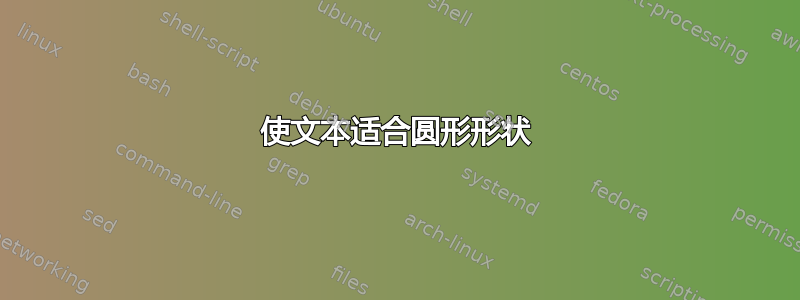
我试图将文本放入箭头内,但形状为圆形,但是文本无法很好地弯曲。
\documentclass[border=5mm]{standalone}
\usepackage{tikz}
\usetikzlibrary{arrows}
\begin{document}
\begin{tikzpicture}[paths/.style={->, thick, >=stealth'}]
\node (species_1) at (-3,0.5) {};
\node (species_2) at (0,0)
{};
\node (species_3) at (2,-2)
{};
\node (species_4) at (0,-4)
{};
\node (species_5) at (-2,-2)
{};
\node (species_6) at (-3,-4)
{};
\draw[-triangle 90 cap, very thick,double, double distance=9pt] (species_2) to [bend left=40] node[black, sloped,bend left=40]{Develop} (species_3);
\draw[-triangle 90 cap, very thick,double, double distance=9pt] (species_3) to [bend left=40] node[black, sloped] {Design} (species_4);
\draw[-triangle 90 cap, very thick,double, double distance=9pt] (species_4) to [bend left=40] node[black, sloped] {Plan} (species_5);
\draw[-triangle 90 cap, very thick,double, double distance=9pt] (species_5) to [bend left=40] node[black, sloped] {Deploy} (species_2);
\draw[-triangle 90 cap, very thick,double, double distance=9pt] (species_6) to node[black, sloped] {Plan}(species_4);
\end{tikzpicture}
\end{document}
更新,
我设法使用提供的链接中的代码,现在我如何使用相同的代码使相同的图形垂直对齐?
代码:
\documentclass[border=5pt]{standalone}
\usepackage{xcolor}
\definecolor{ocre}{HTML}{800000}
\definecolor{sky}{HTML}{C6D9F1}
\definecolor{skybox}{HTML}{5F86B3}
\usepackage{tikz}
\usepackage{pgfmath}
\usetikzlibrary{decorations.text, arrows.meta,calc,shadows.blur,shadings}
% arctext from Andrew code with modifications:
%Variables: 1: ID, 2:Style 3:box height 4: Radious 5:start-angl 6:end-angl 7:text {format along path}
\def\arctext[#1][#2][#3](#4)(#5)(#6)#7{
\draw[#2] (#5:#4cm+#3) coordinate (above #1) arc (#5:#6:#4cm+#3)
-- (#6:#4) coordinate (right #1) -- (#6:#4cm-#3) coordinate (below right #1) arc (#6:#5:#4cm-#3) coordinate (below #1)
-- (#5:#4) coordinate (left #1) -- cycle;
\def\a#1{#4cm+#3}
\def\b#1{#4cm-#3}
\path[
decoration={
raise = -0.5ex, % Controls relavite text height position.
text along path,
text = {#7},
text align = center,
},
decorate
]
(#5:#4) arc (#5:#6:#4);
}
%arcarrow, this is mine, for beerware purpose...
%Function: Draw an arrow from arctex coordinate specific nodes to another
%Arrow start at the start of arctext box and could be shifted to change the position
%to avoid go over another box.
%Var: 1:Start coordinate 2:End coordinate 3:angle to shift from acrtext box
\def\arcarrow(#1)(#2)[#3]{
\draw[thick,->,>=latex]
let \p1 = (#1), \p2 = (#2), % To access cartesian coordinates x, and y.
\n1 = {veclen(\x1,\y1)}, % Distance from the origin
\n2 = {veclen(\x2,\y2)}, % Distance from the origin
\n3 = {atan2(\y1,\x1)} % Angle where acrtext starts.
in (\n3-#3: \n1) -- (\n3-#3: \n2); % Draw the arrow.
}
\begin{document}
\begin{tikzpicture}[
% Environment Cfg
font=\sf \scriptsize,
% Styles
myarrow/.style={
thick,
-latex,
},
Center/.style ={
circle,
fill=ocre,
text=white,
align=center,
font =\footnotesize\bf,
inner sep=1pt,
},
RedArc/.style ={
color=black,
thick,
fill=ocre,
blur shadow, %Tikzedt not suport online view
},
SkyArc/.style ={
color=skybox,
thick,
fill=sky,
blur shadow, %Tikzedt not suport online view
},
]
% Drawing the center
\node[Center](SOSA) at (0,0) {Team 1\\ Blog};
\coordinate (SOSA-R) at (0:1.2); % To make compatible with \arcarrow macro.
% Drawing the Tex Arcs
% \Arctext[ID][box-style][box-height](radious)(start-angl)(end-angl){|text-styles| Text}
\arctext[SSN][SkyArc][8pt](1.5)(25)(-20){|\footnotesize\color{black}|Design};
\arctext[SCap][SkyArc][8pt](1.5)(75)(27){|\footnotesize\color{black}| Develop};
\arctext[SRel][SkyArc][8pt](1.5)(107)(77){|\footnotesize\color{black}| Test};
\arctext[SRel][SkyArc][8pt](1.5)(152)(109){|\footnotesize\color{black}|Deploy};
\arctext[SRel][SkyArc][8pt](1.5)(200)(154){|\footnotesize\color{black}|Review};
\draw[-stealth, ultra thick](-2,-1)to node[below, midway]{Sprint 1}++(4,0);
%Drawing the Arrows
%\arcarrow(above/below ID)(abobe/below ID)[shift]
% %Same level Arrows
% \draw[myarrow] (left SSNX) -- (right DUAM);
% \draw[myarrow] (left SSN) -- (left SRel);
% \draw[myarrow] (left SCap) -- (right SSN);
\end{tikzpicture}
\end{document}
答案1
当机器人更新这篇文章中的某些内容时,我看到了这一点,因此既然我在这里,我必须留下一些简化的代码,其中包含一些按要求解释的内容。我添加了一些我一路学到的东西。
结果:
梅威瑟:
\documentclass[border=5pt]{standalone}
\usepackage[dvipsnames]{xcolor}
\usepackage{tikz}
\usepackage{pgfmath}
\usetikzlibrary{decorations.text, arrows.meta,calc,shadows.blur,shadings}
% arctext from Andrew code with modifications:
%Variables: 1: ID, 2:Style 3:box height 4: Radious 5:start-angl 6:end-angl 7:text {format along path}
\def\arctext[#1][#2][#3](#4)(#5)(#6)#7{
\draw[#2] (#5:#4cm+#3) coordinate (above #1) arc (#5:#6:#4cm+#3)
-- (#6-5:#4) coordinate (right #1) -- (#6:#4cm-#3) coordinate (below right #1) arc (#6:#5:#4cm-#3) coordinate (below #1)
-- (#5-5:#4) coordinate (left #1) -- cycle;
\path[
decoration={
raise = -0.5ex, % Controls relavite text height position.
text along path,
text = {#7},
text align = center,
},
decorate
]
(#5-5:#4) arc (#5-5:#6:#4);
}
\begin{document}
\begin{tikzpicture}[
% Styles
ShdShape/.style ={
color=#1!50!black,
thick,
upper left=#1,
upper right=black!50!#1,
lower left=white,
lower right=blue!50!#1,
blur shadow, %Tikzedt not suport online view
}
]
% you can anidate this in a new drawing definition
\def\Sprint[#1](#2)[#3]#4#5#6#7#8{
\begin{scope}[shift={(#1)},rotate=#2]
\node[ShdShape=gray,draw,align=center,circle](CENTER) at (0,0) {Team #3 \\ Blog};
\arctext[SSN][ShdShape=orange][8pt](2)(25)(-20){|\footnotesize\color{black}|#8};
\arctext[SCap][ShdShape=yellow][8pt](2)(75)(27){|\footnotesize\color{black}|#7};
\arctext[SRel][ShdShape=lime][8pt](2)(107)(77){|\footnotesize\color{black}|#6};
\arctext[SRel][ShdShape=green][8pt](2)(152)(109){|\footnotesize\color{black}|#5};
\arctext[SRel][ShdShape=SeaGreen][8pt](2)(200)(154){|\footnotesize\color{black}|#4};
\draw[-stealth, ultra thick](-2,-1)to node[below, midway,rotate=#2]{Sprint #3}++(4,0);
\end{scope}
}
%Then draw many of these in other positions...
\Sprint[0,0](0)[1]{Design}{Develop}{Test}{Deploy}{Review}
\Sprint[0,4](0)[2]{Task 1}{Task 2}{Task 3}{Task 4}{Task 5}
\Sprint[5,4](-45)[3]{Task 6}{Task 7}{Task 8}{Task 9}{too much...}
%Or you can shift or rotate a part of new drawings using scope.
\begin{scope}[shift={(5,0)},rotate=15]
\node[ShdShape=white,draw,align=center,circle,text=black](CENTER) at (0,0) {Team X \\ Blog};
\arctext[SSN][ShdShape=blue!50!green][8pt](1)(180)(0){|\footnotesize\color{black}|personalized};
\arctext[SCap][ShdShape=cyan][8pt](1)(180)(360){|\footnotesize\color{black}|option};
\end{scope}
\end{tikzpicture}
\end{document}
答案2
希望您期待这一点(感谢Herbert Voss and Timothy Van Zandt发布PSTricks教程):
\documentclass[12pt]{book}
\usepackage{PSTricks}
\usepackage{pst-text}
\begin{document}
\LARGE
\psset{linestyle=none}%
\pstextpath[c]{\psarcn(0,0){1.8}{180}{0}}{Centre National de la}
\pstextpath[c]{\psarc(0,0){1.8}{180}{0}}{Recherche Scientifique}
\end{document}
请注意使用LaTeX->dvips->PS2PDF以获得更好的输出...




